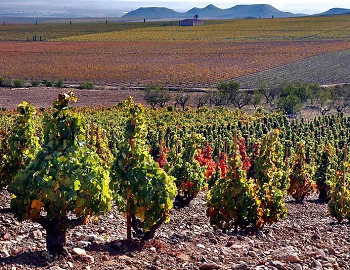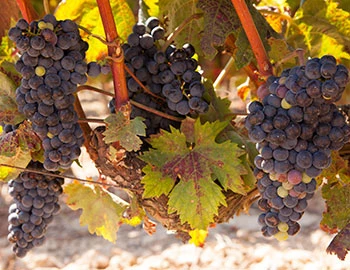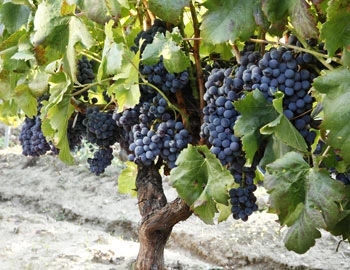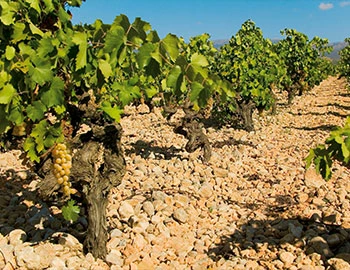
La Montesa Reserva Selección Especial 2015
DOC Rioja, Bodega Palacios Remondo, 750 ml

| Grape variety: | Garnacha, Tempranillo, Mazuelo, Graciano |
| Producer: | Bodega Palacios Remondo |
| Origin: | Spain / Rioja |
| Other vintages: |
Description
Its variety of aromas impresses with notes of ripe plums, dried fruits, Arabic spices, liquorice and the fine fragrance of mocha, vanilla and sandalwood of the wood finish. Its intense flavour is accompanied by smooth tannins, which are silky and soft on the palate. With its long finish, it gives the taste experience of a grand Rioja.
Best wine trader for matured wines 2024

Baur au Lac Vins was honoured by Falstaff as the best wine merchant for mature wines. Thank you very much for the award!
Attributes
| Origin: | Spain / Rioja |
| Grape variety: | Garnacha, Tempranillo, Mazuelo, Graciano |
| Ripening potential: | 8 to 15 years after harvest |
| Drinking temperature: | 16 to 18 °C |
| Food Pairing: | Roasted lamb gigot, Wild specialities |
| Vinification: | fermentation in wooden barrel, cooling period |
| Harvest: | hand-picking, strict selection, in small boxes |
| Maturation: | in partly new and used barriques/ Pièces |
| Bottling: | no filtration |
| Maturation duration: | 16 months |
| Volume: | 14.0 % |
| Note: | Contains sulphites |
Bodega Palacios Remondo
He was born 'at home', right above his father's bodega – Álvaro Palacios, Spains star vintner. The scent of wine and barrels must have been lying in the air and thus dictated his further life. He studied oenology in Bordeaux and gathered professional experience at the Château Pétrus, and in London, Dublin, and California. Today, he owns vines in the Priorat county, in Bierzo, and at home in the Rioja, and proves his extraordinary talent with premium wines year after year.
He loves his family, motorcycles, nature, songs by Camarón, a challenge and taking risks. He seems believable when he confesses that his second calling would have been to be a 'torero', a bullfighter. He bristles with dynamism and power.
He went to Bordeaux to study oenology when he was 21 years old. The next stage saw him working at the Château Pétrus for two years. Then he returned home. His father José Palacios Remondo had built a bodega in close to Alfaro in 1948 following a family tradition dating back to 1651. However, Álvaro felt constricted upon his return. In 1989, he was pulled towards the abandoned Priorat, where his first resounding success would take place shortly. He was restless to hurry to the next challenge in Bierzo, where he prompted the next furore. His international reputation as a star winegrower had already been established when his father died in 2000. This marked the right moment to return home – his birthplace.

Mazuelo
Fervid oddball
The red Carignan is a heat-loving Mediterranean grape. It has a bit of everything over other varieties: more colour, more tannins, more acid. It is not easy to press a harmonious wine from it alone. Hence it is most often encountered as a blend partner, as in the Côtes du Rhône wines. In Spain it is called Mazuelo and is part of the traditional Rioja recipe. It provides the wines’ acidic backbone. The most exciting varietal specimens come from the slate slopes of the Catalan Priorat, from old bush vines in Chile or from Sardinia, where it is known as Carignano. When pressed properly, this oddball generates a lush bouquet of plums and dark fruits. Its origins lie in the northwest Spanish Aragon, near the town of Cariñena. The surrounding wine area is also named after it. In order to prevent confusion with the vine, it is called Samsó there.

Graciano
A small, mundane black one
Graciano is an old red variety, originally from Sardinia. However, it was propagated diligently after the Spanish occupation of the island in the 16th century. Thus, today it is found in the Languedoc-Roussillon region of southern France, Bulgaria, Tunisia, Algeria, Argentina, Brazil and South Africa, among others. But this vine achieved particular importance in Spain.
Until 1850, Graciano was one of the most important varieties in Rioja. But the phylloxera epidemic afflicted the Graciano so seriously that it was threatened with extinction. In 1991, the Rioja region was classified as a controlled region of origin, whereby Graciano experienced an upturn.
The late-maturing, low-yielding vine generates small blue-black bunches with extremely hard-skinned berries. Purely Graciano wines are dark in color with striking acidity and intense tannins. In blends, Graciano lends acidity, structure and bouquet to red wines. It also enhances the aging potential.

Tempranillo
Iberian Native
The Tempranillo is the emblem of Spain. With its juicy cherry fruit, crisp tannins, and its notes of leather and spices, it gives the Rioja its face. In the Ribera del Duero, it is known as Tinta del país. Here it turns out focused and muscular. As it has inhabited the Iberian Peninsula for centuries, it is known under countless synonyms. Across the border in Portugal, it is called Tinta Roriz, and lends colour and body to port wine. It also plays an important role in the booming wine scene of the Douro Valley. The Tempranillo owes its name to its early maturity – "temprano" in Spanish means "early". Tip: do it like they do in Spain and enjoy it with lamb.

Garnacha
Grenache seldom comes alone
Spaniards and Sardinians make the Grenache contentious: both claim it originated from their country. In fact, it had already appeared in both places by the 16th century. But a large number of mutations in Spain indicates that it has deeper roots on the Iberian Peninsula. The Grenache is meaty, rich in tannins and spicy, with a wonderful, fruity sweetness and rich aromas of blackberry, cassis, plums and pepper. Under the name Garnacha, it contributes fullness to the Rioja. In Sardinia it is called Cannonau, where it yields strong, expressive wines. But its stronghold is in France. Grenache is the star in Châteauneuf-du-Pape and streams into many other assemblages from the south. Its preferred partners are Syrah and Mourvèdre. This blend is also very popular abroad. In Australia, these wines are simply called "GSM".

Rioja
Rioja: A legend in upheaval
It is the flagship of the Spanish wine industry: the Rioja region, with its elegant, yet storable wines, most of which are dominated by the Tempranillo, has decisively influenced the image of Spanish wine. Above all, the Reservas and Gran Reservas, aged for years in barrels, enjoy a magical reputation. For about 20 years, the Rioja houses have created a sensation with modern-designed, fruity wines, which are marked more by their terroir than their aging processes.

Spain
Spain – Variety and perfection
“Somewhere in la Mancha, in a place whose name I do not care to remember...,” begins Don Quixote's odyssey.
The most famous part is definitely when Don Quixote thinks windmills are his enemy and wants to fight them – until they nearly kill him. It’s possible there was a bit too much of the La Mancha wine at play. Spanish vines fight for their survival in rugged landscapes, battling fierce drought and rough soils. But they fight well.


